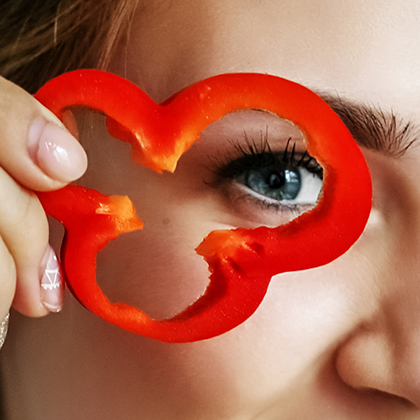
Receiving a diagnosis of glaucoma can be a shock and sometimes stressful as you juggle appointments with doctors and hospital specialists. You may also be wondering what you can do to help yourself. It may be of interest to you whether your diet can support your eyes and manage your condition. Within this piece, we will explore whether dietary changes can help support glaucoma treatment.
Current research on diet and glaucoma
According to the US-based Glaucoma Research Foundation, there aren’t any conclusive studies that prove any connection between specific foods and glaucoma. But it’s reasonable to assume that what you eat and drink could have an effect on the condition.
There are studies that suggest dietary factors may have an effect on eye pressure (intraocular pressure or IOP), which is a major risk factor for glaucoma. In fact, reducing IOP is the mainstay of medical treatment for glaucoma, including using IOP-reducing medication (eye drops), laser treatment and surgery. Yet there’s a lack of information on lifestyle factors that lower IOP and whether they have any real impact on glaucoma, and experts currently agree that more research into nutrition and glaucoma is very much needed.
That said, let’s take a look at the evidence on diet and its effect on glaucoma and IOP to date so that you can make your own mind up.
Fruit and vegetables
Since some studies suggest oxidative stress may play a part in the development of glaucomai, you may want to make sure your diet includes plenty of antioxidant-rich foods. Antioxidants are molecules made in the body and found in our diet. They are thought to protect us against chemicals called free radicals that cause damage to cells through a process called oxidation or oxidative stress. Many antioxidants are found in plant-based foods, particularly those that are richly coloured since it’s the pigment in these plants that have antioxidant capabilities.
Some studies show people who eat plenty of fruit and vegetables may have a lower risk of glaucoma. One suggests older women who eat produce rich in vitamin A (an antioxidant vitamin) and carotenes (one of several groups of plant pigments) – including kale, carrots and peaches – have a reduced glaucoma risk.ii Another concludes the risk of glaucoma may be lower in older women who eat fruit and vegetables rich in carotenes plus the antioxidant vitamins A and C.iii
 Other substances found in foods such as green leafy vegetables, called nitrates, have been found to lower the risk of the most common form of glaucoma, namely primary open angle glaucomaiv. As well as foods such as spinach and lettuce, nitrates are also found naturally in beetroot, celery and radishes.
Other substances found in foods such as green leafy vegetables, called nitrates, have been found to lower the risk of the most common form of glaucoma, namely primary open angle glaucomaiv. As well as foods such as spinach and lettuce, nitrates are also found naturally in beetroot, celery and radishes.
Find out more about how antioxidants may help boost your eyesight by reading Antioxidants and Eye Health: Breaking down the Facts.
Tea and coffee
What you drink may be an issue too, since studies suggest caffeine – found in both tea and coffee – can raise IOP, albeit temporarily, both in people with glaucomav and those withoutvi. One study has discovered people with glaucoma who say they regularly drink caffeine or coffee have a higher average IOP than those who don’t drink any coffeevii. On the other hand, studies looking into the rates of glaucoma and caffeine consumption (as opposed to caffeine consumption and IOP) have yet to establish a strong link.
Although tea contains caffeine, there is some encouraging evidence it may be helpful to those with glaucoma, thanks to antioxidant chemicals it contains called flavonoids.
A study suggests those who drink at least one cup of hot caffeinated tea every day maybe 74 per cent less likely to have glaucoma than those who prefer their tea decaffeinated or iced – or no tea at all.viii
Herbs
Used to colour and flavour foods such as rice, saffron may be a useful addition to your herb rack if you have glaucoma, suggests one study that found the herb extract may help reduce IOP in people with glaucomaix.
Ginkgo biloba extract, meanwhile, may be helpful too, with studies suggesting it increases blood flow in the eyes in people with glaucomaxi, and that it may protect against oxidative stressi. Elsewhere a small-scale study suggests a daily 40mg dose of ginkgo may even improve pre-existing visual field damage in some people with normal tension glaucoma (the type of glaucoma that isn’t related to increased IOP)xii.
Oily fish
Omega-3 fatty acids are found in oily fish such as salmon, herring, trout, pilchards and mackerel. Implementing omega 3 into your diet may be a good idea, as one study suggests fish oil supplements lower IOP in people with normal blood pressurexiii. The NHS suggests a healthy diet should include at least two portions of fish a week, one of which should be oily. If you can’t, or don’t want to, eat fish, a good-quality fish oil supplement may be an ideal alternative.
Glaucoma and body mass index
Meanwhile, your weight may also play a part in the health of your vision. Body mass index (BMI) is the most commonly used measurement of body fat adjusted for height in adults, and is calculated as weight in kilograms divided by height in meters squared. Having a high BMI is a known risk factor for many conditions, including type 2 diabetes, high blood pressure, coronary artery disease and stroke. Diabetes especially has been linked to eye health, find out how you can improve and maintain your vision here.
However, BMI has been linked with increased IOP in several studiesxiv, with one suggesting greater fat mass is associated with higher IOP and greater muscle mass associated with lower IOP in healthy womenxv. Despite these results, researchers still aren’t sure exactly why BMI is linked with raised IOP.
Experts agree that the ideal BMI is in the 18.5 - 24.9 range. For more information on weight management, visit our Pharmacy Health Library.
If you’re interested in other ways your lifestyle can affect your eye health, there’s lots more information in our Vision Health Hub.
References:
-
Kumar, D.M., Agarwal, N. Oxidative stress in glaucoma: A burden of evidence. J Glaucoma. (2007) ;16:334–343. Available online: https://www.ncbi.nlm.nih.gov/pubmed/17438430
-
Coleman, A.L., et al. Glaucoma risk and the consumption of fruits and vegetables among older women in the study of osteoporotic fractures. Am J Ophthalmol. (2008 Jun) ;145(6):1081-9. Available online: https://www.ncbi.nlm.nih.gov/pubmed/18355790
-
Giaconi, J.A., et al. The association of consumption of fruits/vegetables with decreased risk of glaucoma among older African-American women in the study of osteoporotic fractures. Am J Ophthalmol. (2012 Oct) ;154(4):635-44. Available online: https://www.ncbi.nlm.nih.gov/pubmed/22818906
-
Kang, J.H., et al. Association of Dietary Nitrate Intake With Primary Open-Angle Glaucoma: A Prospective Analysis From the Nurses' Health Study and Health Professionals Follow-up Study. JAMA Ophthalmol. (2016 Mar) ;134(3):294-303. Available online: https://www.ncbi.nlm.nih.gov/pubmed/26767881
-
Jiwani, A.Z., Rhee, D.J., Brauner, S.C., et al. Effects of caffeinated coffee consumption on intraocular pressure, ocular perfusion pressure, and ocular pulse amplitude: a randomized controlled trial. Eye (Lond). (2012) :26(8):1122–1130. Available online: https://www.ncbi.nlm.nih.gov/pubmed/22678051
Avisar, R., Avisar, E., Weinberger, D. Effect of coffee consumption on intraocular pressure. Ann Pharmacother. (2002) :36(6):992–995. Available online: https://www.ncbi.nlm.nih.gov/pubmed/12022898
Higginbotham, E.J., Kilimanjaro, H.A., Wilensky, J.T., Batenhorst, R.L., Hermann, D. The effect of caffeine on intraocular pressure in glaucoma patients. Ophthalmology. (1989) :96(5):624–626. Available online: https://www.ncbi.nlm.nih.gov/pubmed/2636858 -
Ajayi, O.B., Ukwade, M.T. Caffeine and intraocular pressure in a Nigerian population. J Glaucoma. (2001) ;10(1):25–31. Available online: https://www.ncbi.nlm.nih.gov/pubmed/11219635
Li, M., Wang, M., Guo, W., Wang, J., Sun, X. The effect of caffeine on intraocular pressure: a systematic review and meta-analysis. JGraefes Arch Clin Exp Ophthalmol.. (2011) ;249(3):435–442. Available online: https://www.ncbi.nlm.nih.gov/pubmed/20706731 -
Chandrasekaran, S., Rochtchina, E. , Mitchell, P. Effects of caffeine on intraocular pressure: the Blue Mountains Eye Study. J Glaucoma (2005) ;14(6):504–507. Available online: https://www.ncbi.nlm.nih.gov/pubmed/16276285
-
Wu, C.M., et al. Frequency of a diagnosis of glaucoma in individuals who consume coffee, tea and/or soft drinks. Br J Ophthalmol. (2018 Aug) ;102(8):1127-1133. Available online: https://www.ncbi.nlm.nih.gov/pubmed/29242183
-
Jabbarpoor Bonyadi, M.H., Yazdani, S., Saadat, S. The ocular hypotensive effect of saffron extract in primary open angle glaucoma: a pilot study. BMC Compl Altern Med. (2014) ;14:399. Available online: https://www.ncbi.nlm.nih.gov/pubmed/25319729
-
Chung, H.S., Harris, A., Kristinsson, J.K., Ciulla, T.A., Kagemann, C., Ritch, R. Ginkgo biloba extract increases ocular blood flow velocity. J Ocul Pharmacol Ther. (1999) ;15(3):233–240. Available online: https://www.ncbi.nlm.nih.gov/pubmed/10385132
-
Eckert, A., Keil, U., Scherping, I., Hauptmann, S., Müller, W.E. Stabilization of mitochondrial membrane potential and improvement of neuronal energy metabolism by Ginkgo biloba extract EGb 761. Ann N Y Acad Sci. (2005) ;1056:474–485. Available online: https://www.ncbi.nlm.nih.gov/pubmed/16387710
-
Quaranta, L., Bettelli, S., Uva, M.G., et al. Effect of Ginkgo biloba extract on preexisting visual field damage in normal tension glaucoma. Ophthalmology. (2003) ;110:359-362. Available online: https://www.ncbi.nlm.nih.gov/pubmed/12578781
-
Downie, L.E., Vingrys, A.J. Oral Omega-3 Supplementation Lowers Intraocular Pressure in Normotensive Adults. Transl Vis Sci Technol. (2008 May) ;7(3): 1. Available online: https://www.ncbi.nlm.nih.gov/pmc/articles/PMC5931260
-
Cohen, E., et al. Relationship Between Body Mass Index and Intraocular Pressure in Men and Women: A Population-based Study. J Glaucoma. (2016 May) ;25(5):e509-13. Available online: https://www.ncbi.nlm.nih.gov/pubmed/26766402
Kim, Y.K., Choi, H.J., Jeoung, H.J., Park, KM., Kim, D.M. Five-year incidence of primary open-angle glaucoma and rate of progression in health center-based Korean population: the Gangnam Eye Study. PLoS One. (2014) ;9(12):e114058. Available online: https://www.ncbi.nlm.nih.gov/pubmed/25474589 -
Kim, H.T., Kim, J.M, Kim, J.H., et al. Relationships between anthropometric measurements and intraocular pressure: the Korea National Health and Nutrition Examination Survey. Am J Ophthalmol. (2017) ;173:23–33. Available online: hhttps://www.ncbi.nlm.nih.gov/pubmed/27702621
Related Posts?
Disclaimer: The information presented by Nature's Best is for informational purposes only. It is based on scientific studies (human, animal, or in vitro), clinical experience, or traditional usage as cited in each article. The results reported may not necessarily occur in all individuals. Self-treatment is not recommended for life-threatening conditions that require medical treatment under a doctor's care. For many of the conditions discussed, treatment with prescription or over the counter medication is also available. Consult your doctor, practitioner, and/or pharmacist for any health problem and before using any supplements or before making any changes in prescribed medications.

Christine
Christine Morgan has been a freelance health and wellbeing journalist for almost 20 years, having written for numerous publications including the Daily Mirror, S Magazine, Top Sante, Healthy, Woman & Home, Zest, Allergy, Healthy Times and Pregnancy & Birth; she has also edited several titles such as Women’ Health, Shine’s Real Health & Beauty and All About Health.
View More



